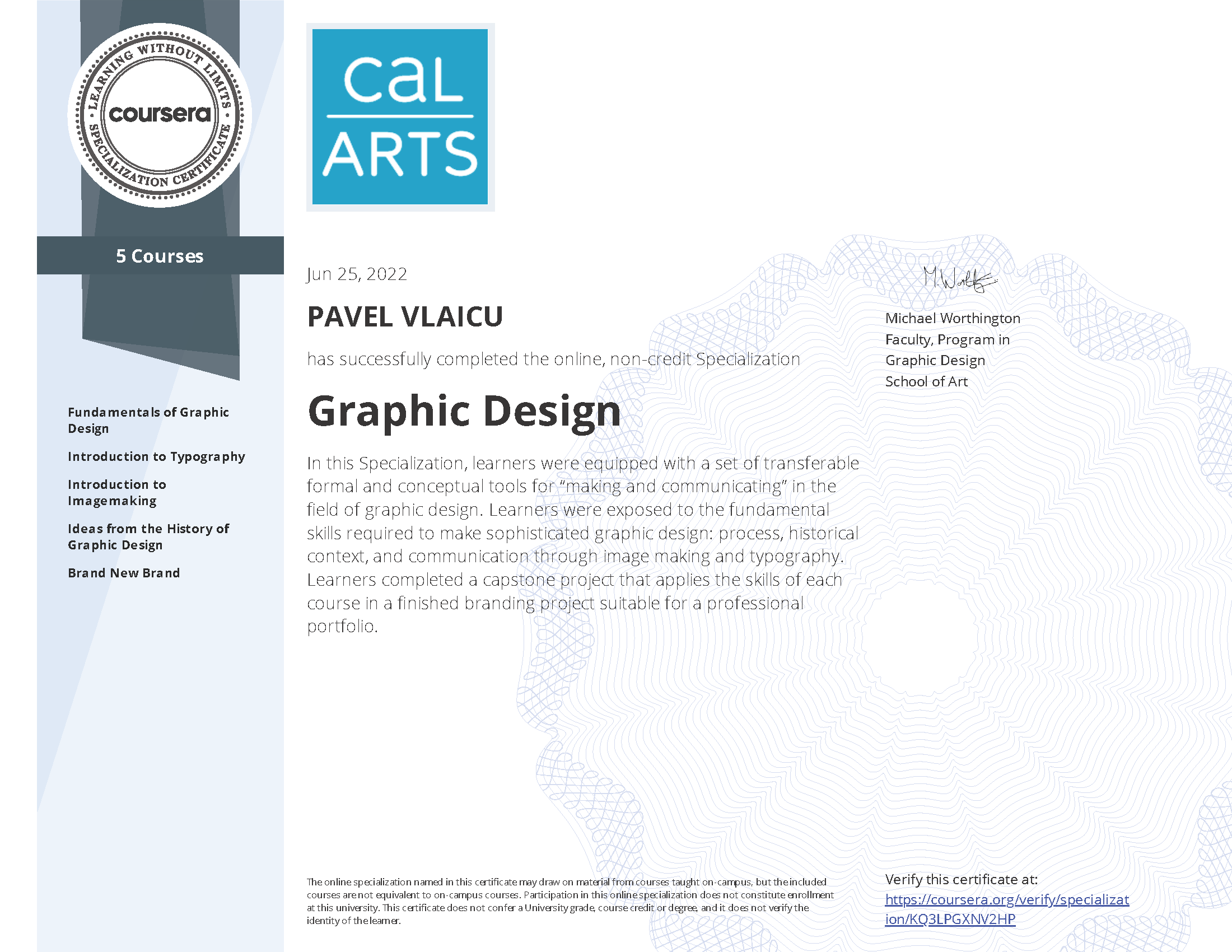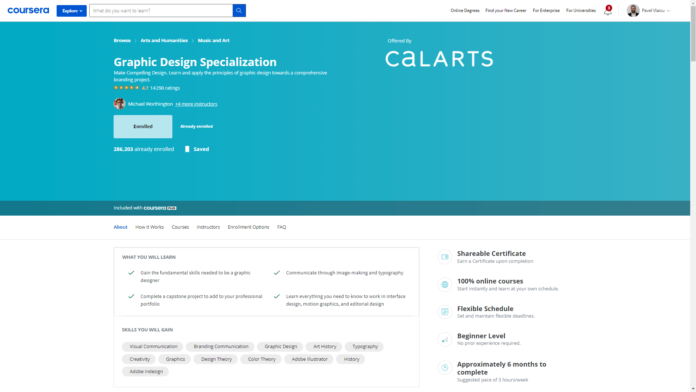What you will learn
Gain the fundamental skills needed to be a graphic designer
Communicate through image-making and typography
Complete a capstone project to add to your professional portfolio
Learn everything you need to know to work in interface design, motion graphics, and editorial design
Skills you will gain
Visual Communication
Branding Communication
Graphic Design
Art History
Typographyt
Creativity
Graphics
Design Theory
Color Theory
Adobe Illustrator
History
Adobe Indesign
About this Specialization
Graphic design is all around us, in a myriad of forms, both on screen and in print, yet it is always made up of images and words to create a communication goal. This four-course sequence exposes students to the fundamental skills required to make sophisticated graphic design: process, historical context, and communication through image-making and typography. The sequence is completed by a capstone project that applies the skills of each course and peer feedback in a finished branding project suitable for a professional portfolio.
The goal of this specialization is to equip learners with a set of transferable formal and conceptual tools for “making and communicating” in the field of graphic design. This core skill set will equip learners for formal studies in graphic design, and a starting point for further work in interface design, motion graphics, and editorial design.
How the Specialization Works
Take Courses
A Coursera Specialization is a series of courses that helps you master a skill. To begin, enroll in the Specialization directly, or review its courses and choose the one you’d like to start with. When you subscribe to a course that is part of a Specialization, you’re automatically subscribed to the full Specialization. It’s okay to complete just one course — you can pause your learning or end your subscription at any time. Visit your learner dashboard to track your course enrollments and your progress.
Hands-on Project
Every Specialization includes a hands-on project. You’ll need to successfully finish the project(s) to complete the Specialization and earn your certificate. If the Specialization includes a separate course for the hands-on project, you’ll need to finish each of the other courses before you can start it.
Earn a Certificate
When you finish every course and complete the hands-on project, you’ll earn a Certificate that you can share with prospective employers and your professional network.
There are 5 Courses in this Specialization
Course 1
Fundamentals of Graphic Design
Graphic Design is all around us! Words and pictures—the building blocks of graphic design—are the elements that carry the majority of the content in both the digital world and the printed world. As graphic design becomes more visible and prevalent in our lives, graphic design as a practice becomes more important in our culture.
Through visual examples, this course will teach you the fundamental principles of graphic design: imagemaking, typography, composition, working with color and shape… foundational skills that are common in all areas of graphic design practice. I don’t just want you to watch a video of someone talking about design, I want you to MAKE design! If you want to be a designer you have to be a maker and a communicator, so this course will offer you lots of opportunities to get your hands dirty with exercises and with more practical projects.
At the end of this course you will have learned how to explore and investigate visual representation through a range of image-making techniques; understand basic principles of working with shape, color and pattern; been exposed to the language and skills of typography; and understand and have applied the principles of composition and visual contrast. If you complete the course, along with its optional (but highly recommended) briefs, you will have a core set of graphic design skills that you can apply to your own projects, or to more deeply investigate a specialized area of graphic design.
To succeed in this course you will need access to a computer. You can complete this course without one but it will be tougher. Access to, and a beginner’s level knowledge of Adobe Creative Suite programs, such as Illustrator, Photoshop and InDesign will help you, especially if you want to complete the optional briefs.
Course 2
Introduction to Typography
Typography is the art of manipulating the visual form of language to enrich and control its meaning. It’s an essential area of skill and knowledge for graphic designers. Typography predates modern graphic design by around 500 years; it is rich in rules, conventions, and esoteric terminology—but it remains an exciting space for invention and expression.
In this rigorous introductory course, we will study, name, and measure the characteristics of letterforms. We’ll consider the pragmatic concerns involved in selecting and combining type. We’ll peek into the rich historical, cultural, and aesthetic histories of familiar typefaces. We’ll discuss time-tested conventions and best practices in setting type, as governed by principles of hierarchy and spatial organization. And we’ll explore the expressive, meaning-making potential of type.
Informative lectures will be complemented by a series of three peer-assessed assignments, culminating in an opportunity to design a full-scale typographic poster.
Please note that this is not a software course; a basic working knowledge of Adobe InDesign or other page layout software will be assumed. You will need access to a computer and page layout software, such as InDesign, to complete the assignments.
Course 3
Introduction to Imagemaking
This course for serious makers, and for students new to imagemaking. Imagemaking is a fluid and exciting area of graphic design that comes out of practice and process: experimenting fearlessly, showing and sharing ideas, and giving and receiving knowledgeable and constructive input.
For the sake of this online platform, we have applied some structure to our investigations, but for the most part imagemaking is loose and unstructured. If we must adopt a rule in this course it is only this: you will not become a graphic designer by watching videos alone. Or, don’t just make stuff just in your head. So here, the focus here is on making, and you are expected to devote serious time and intellectual energy to that activity in this course. Specifically, you will:
– experiment with a range of materials and techniques to make images for graphic design
– expand your visual vocabulary both in terms of making and talking about work, in order to discuss your work and work of others
– learn how to make, manipulate and arrange images to create compositions, eventually culminating in the design and production of an-image-based book.
The first half of the course is an opportunity to experiment and explore imagemaking in order to expand your visual vocabulary. You will create pieces that are expressive, meditative, or ‘design-y’ to instigate, evoke, experiment, record, explain, or try out a media.
In the second two weeks, we’ll invite the images to deliberately and intentionally carry meaning and communication through relational moves like juxtaposition, composition, and context. We’ll look at developing and expanding the range of approaches for putting things together by composing page spreads with your images. Since nothing exists without context, we look at how to intentionally drive the image’s connotations, meanings, and associations generated through elements of composition and “visual contrasts.” Ultimately, we will take the images that you create and make a book from them.
The results of your assignments (and experiments) may generate something completely unknowable now or in the future—and that’s the goal.
Course 4
Ideas from the History of Graphic Design
This condensed survey course focuses on four key periods or themes from the history of design in the West. Together we’ll trace the emergence of design as a recognized practice, why things look the way they do, and how designers approached specific design problems in their work.
Students will develop an understanding of where the wide variety of today’s design practice comes from. By participating in this survey of the works of innovative groups and individuals, we outline the process by which graphic design moved from a purely instrumental practice, to becoming a demanding creative and hybridized field.
Each week, a short quiz will test your knowledge of concepts, and a short reflective assignment will give you the opportunity to analyze the questions designers ask themselves today.
This is an essential course for emerging designers entering the field, or for students interested in learning more about visual culture and analysis. No previous experience is required.
A note about this course:
This course is taught from the perspective of contemporary design, to connect ideas that helped formulate design practice from the 1850s through the 1960s to the ways that designers think today. The relationship of words and pictures in graphic design is looked at through the ever-changing social and cultural contexts, technologies, aesthetics, and politics of their eras.
The definition and practice of graphic design includes all public visual communications, which is a global practice. It was the evolution of mass production and communication in the West that specifically redefined graphic design as a professional practice and is this course’s particular narrative. We hope students will consider how to connect the themes and ideas offered in this course to your own culture.
Course 5
Brand New Brand
This course is the culmination of the Graphic Design Specialization and gives you an opportunity to tie together your knowledge and skills into a single project: a brand development guide for a company you will invent.
This course takes you through the entire design process, from ideation to creation to presentation. Through the guide, you will be creating and giving a visual identity to an imaginary start-up company, and applying that visual identity to a number of forms. You will also develop a logotype and accompanying graphic palette to visually represent your company, as well as apply that design to a number of different applications to see it at work.
Note: Only learners who have earned a certificate in the four previous courses in the Specialization are eligible to take the Capstone.

Instructors
Michael Worthington
Faculty, Program in Graphic Design
School of Art
Anther Kiley
Instructor
Gail Swanlund
Faculty in Graphic Design
School of Art
Louise Sandhaus
Faculty, Program in Graphic Design
School of Art
Lorraine Wild
Faculty, Program in Graphic Design
School of Art
Offered by
California Institute of the Arts
CalArts has earned an international reputation as the leading college of the visual and performing arts in the United States. Offering rigorous undergraduate and graduate degree programs through six schools—Art, Critical Studies, Dance, Film/Video, Music, and Theater—CalArts has championed creative excellence, critical reflection, and the development of new forms and expressions.
